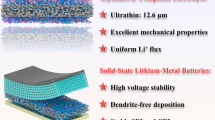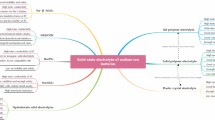Abstract
Polyvinylidene fluoride (PVDF) porous membranes were prepared by non-solvent-induced phase separation (NIPS) method. The membranes were made by different compositions of binary N-methyl-2-pyrrolidone/acetone mixture as the solvent. Ethanol and deionized water were utilized as the non-solvent. The effect of the composition of the two solvents on the structural, mechanical, and electrochemical properties of the membranes was investigated in the lithium-ion batteries (LIBs). Results show that by increasing the N-methyl-2-pyrrolidone (NMP) content of the solvent, the electrolyte uptake of the membrane is increased. Furthermore, using ethanol as non-solvent results in more uniform membranes with higher porosity. All of the synthesized samples demonstrate better results, as compared to the Celgard 2400, except for the tensile strength. Specifically, a membrane with good physical and electrochemical properties is achieved when the ratio of NMP/acetone is 40:60 (by weight). That sample is selected as the optimal membrane. Thermal shrinkage of optimal sample at 160 °C is 37.5% while that is 90.7% for Celgard 2400. Its ionic conductivity and electrochemical stability are 1.2 mS/cm and up to 5 V, respectively. The initial capacity of the optimal sample (NMP/acetone of 40:60) is 141 mAh/g while the reported value for Celgard 2400 is 126 mAh/g. These results indicate that PVDF porous membranes prepared by the proposed NIPS method show good electrochemical stability and cycling performance for the application of LIBs.






Similar content being viewed by others
References
Zhang J, Sun B, Huang X, Chen S, Wang G (2014) Honeycomb-like porous gel polymer electrolyte membrane for lithium ion batteries with enhanced safety. Sci Rep 4:6007
Jiang F, Nie Y, Yin L, Feng Y, Yu Q, Zhong C (2016) Core–shell-structured nanofibrous membrane as advanced separator for lithium-ion batteries. J Membr Sci 510:1–9
Ma M (2017) Electrospun polyacrylonitrile nanofibrous membranes with varied fiber diameters and different membrane porosities as lithium-ion battery separators. Electrochim Acta 236:417–423
Manthiram A (2017) An outlook on lithium ion battery technology. ACS Cent Sci 3(10):1063–1069
Zubi G, Dufo-López R, Carvalho M, Pasaoglu G (2018) The lithium-ion battery: state of the art and future perspectives. Renew Sust Energ Rev 89:292–308
Barbosa J, Dias J, Lanceros-Méndez S, Costa CM (2018) Recent advances in poly (Vinylidene fluoride) and its copolymers for lithium-ion battery separators. Membranes 8(3):45–80
Wang Z, Chen J, Ye B, Pang P, Ma Z, Chen H, Nan J (2020) A pore-controllable polyamine (PAI) layer-coated polyolefin (PE) separator for pouch lithium-ion batteries with enhanced safety. J Solid State Electrochem 24: 843–853
Jana KK, Lue SJ, Huang A, Soesanto JF, Tung KL (2018) Separator membranes for high energy-density batteries. ChemBioEng Rev 5(6):346–371
Zhang H, Zhou MY, Lin CE, Zhu BK (2015) Progress in polymeric separators for lithium ion batteries. RSC Adv 5(109):89848–89860
Wu Q-Y, Liang H-Q, Gu L, Yu Y, Huang Y-Q, Xu Z-K (2016) PVDF/PAN blend separators via thermally induced phase separation for lithium ion batteries. Polymer 107:54–60
Weber CJ, Geiger S, Falusi S, Roth M (2014) Material review of Li ion battery separators. AIP Conf Proc 1597(1):66–81
Costa CM, Lee Y-H, Kim J-H, Lee S-Y, Lanceros-Méndez S (2019) Recent advances on separator membranes for lithium-ion battery applications: from porous membranes to solid electrolytes. Energy Stor Mater 22:346–375
Xu R, Huang X, Lin X, Cao J, Yang J, Lei C (2017) The functional aqueous slurry coated separator using polyvinylidene fluoride powder particles for lithium-ion batteries. J Electroanal Chem 786:77–85
Fu Q (2018) Mechanically reinforced PVdF/ PMMA/SiO2 composite membrane and its electrochemical properties as a separator in lithium-ion batteries. Energy Technol 6(1):144–152
Liu L, Wang Z, Zhao Z, Zhao Y, Li F, Yang L (2016) PVDF/PAN/SiO2 polymer electrolyte membrane prepared by combination of phase inversion and chemical reaction method for lithium ion batteries. J Solid State Electrochem 20(3):699–712
Costa CM, Silva MM, Lanceros-Méndez S (2013) Battery separators based on vinylidene fluoride (VDF) polymers and copolymers for lithium ion battery applications. RSC Adv 3(29):11404–11417
Baskakova YV, Ol'ga YV, Efimov ON (2012) Polymer gel electrolytes for lithium batteries. Russ Chem Rev 81(4):367
Nunes-Pereira J, Costa CM, Lanceros-Méndez S (2015) Polymer composites and blends for battery separators: state of the art, challenges and future trends. J Power Sources 281:378–398
Zhao M, Zuo X, Ma X, Xiao X, Liu J, Nan J (2017) Self-supported PVdF/P (VC-VAc) blended polymer electrolytes for LiNi0. 5Mn1. 5O4/Li batteries. J Membr Sci 532:30–37
Liu J, He C, He J, Cui J, Liu H, Wu X (2017) An enhanced poly (vinylidene fluoride) matrix separator with high density polyethylene for good performance lithium ion batteries. J Solid State Electrochem 21(4):919–925
Liu F, Hashim NA, Liu Y, Abed MM, Li K (2011) Progress in the production and modification of PVDF membranes. J Membr Sci 375(1–2):1–27
Stephan AM (2006) Review on gel polymer electrolytes for lithium batteries. Eur Polym J 42(1):21–42
Pu W, He X, Wang L, Jiang C, Wan C (2006) Preparation of PVDF–HFP microporous membrane for Li-ion batteries by phase inversion. J Membr Sci 272(1–2):11–14
Hwang YG, Jeong SK, Nahm KS, Stephan AM (2007) Electrochemical studies on poly (vinylidene fluoride–hexafluoropropylene) membranes prepared by phase inversion method. Eur Polym J 43(1):65–71
Rahmawati SM (2016) Preparation and characterization of nanocomposite polymer electrolytes poly (vinylidone fluoride)/nanoclay. AIP Conf Proc 1710(1):030053
Huang X (2016) A facile approach to make high performance nano-fiber reinforced composite separator for lithium ion batteries. J Power Sources 323:17–22
Lee MJ (2015) Highly lithium-ion conductive battery separators from thermally rearranged polybenzoxazole. Chem Commun 51(11):2068–2071
Mao X (2017) Polyethylene separator activated by hybrid coating improving Li+ ion transference number and ionic conductivity for Li-metal battery. J Power Sources 342:816–824
Chen W, Liu Y, Ma Y, Liu J, Liu X (2014) Improved performance of PVdF-HFP/PI nanofiber membrane for lithium ion battery separator prepared by a bicomponent cross-electrospinning method. Mater Lett 133:67–70
Author information
Authors and Affiliations
Corresponding author
Additional information
Publisher’s note
Springer Nature remains neutral with regard to jurisdictional claims in published maps and institutional affiliations.
Rights and permissions
About this article
Cite this article
Tabani, Z., Maghsoudi, H. & Fathollahi Zonouz, A. High electrochemical stability of polyvinylidene fluoride (PVDF) porous membranes using phase inversion methods for lithium-ion batteries. J Solid State Electrochem 25, 651–657 (2021). https://doi.org/10.1007/s10008-020-04842-5
Received:
Revised:
Accepted:
Published:
Issue Date:
DOI: https://doi.org/10.1007/s10008-020-04842-5




